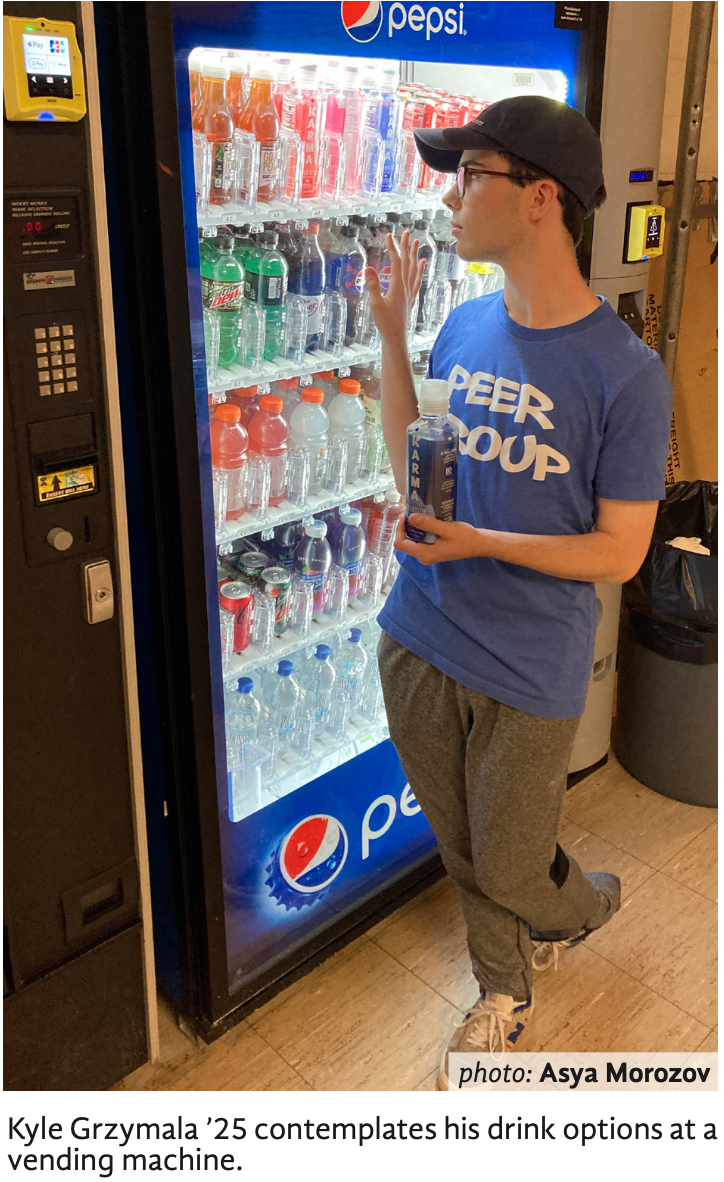Sports drinks: healthy or harmful?
November, 2024
Brightly colored bottles and bold advertisements promise a multitude of benefits for athletes, from enhancing energy to boosting overall performance. These advertisements are highly attractive — according to a 2018 study led by pediatrician Kyla Cordrey, there is a positive correlation between the aggressiveness of energy drink advertisements and the proportion of U.S. high school students who consume them. This trend is evident at PHS: students in the Fitness Center are rarely seen without a bright blue beverage, bottles of Powerade sit on desk corners, and vending machines sell Gatorade G-Zero, vitaminwater, BODYARMOR, and Gatorade Propel. What are the real health benefits of energy drinks, though? What ingredients do they contain? Are they worth peddling to the PHS crowd?
Beyond advertisements, sports drinks are increasingly popular in the United States due to a rising athlete population and greater interest in fitness-related activities, with the sports drink industry projected to reach a value of $36.35 billion in 2028, according to Fortune Business. Furthermore, accessibility through online stores, effective branding, and collaborations with sports teams or celebrities have bolstered the industry through the years. In order to keep up with the current trends, companies have started to change their advertising and packaging to emphasize the use of natural and organic ingredients to reflect the growing support towards sustainability and clean-label sources. However, even with these changes, the main ingredients of the drinks remain largely the same, including large amounts of sugar, carbohydrates, sodium, and caffeine.
A popular sports drink brand and go-to choice for athletes, Gatorade claims their product hydrates better than water due to two additional ingredients: electrolytes and carbohydrates. Electrolytes are minerals essential for maintaining the body’s ionic balance — the balance between the fluids in and outside the cells — which is necessary for muscle, brain, and nerve function. As one of the three main nutrients, carbohydrates are sugar molecules that are eventually broken down into glucose, and are the main source of energy for organs and cells.
However, sports drinks like Gatorade contain excessive amounts of sugar, with some even including caffeine, which can spike blood glucose levels significantly, according to the American Diabetes Association. Regularly having high blood glucose levels can lead to severe or permanent damage in the kidneys, nerves, eyes, and blood vessels. Many companies advertise their products as “zero sugar” to appear healthier but only minorly disclose that the alternative sweeteners they use, such as aspartame and sucralose, may alter healthy gut bacteria, according to Anglia Ruskin University researchers Aparna Shil and Havovi Chichger. The long-term effects of low-calorie sweeteners are unknown, but studies from Harvard University have found them to be correlated with diabetes. Additionally, the vibrant colors of sports drinks are achieved by using artificial dyes such as Red #40, a common additive that has been linked to concerning carcinogenic effects such as tumor growth.
However, despite containing high amounts of sugar and mysterious additives, sports drinks can be beneficial when consumed during intense exercise, where extra calories and sugar are offset by the energy burned during the workout. According to the Academy of Pediatrics, sports drinks may be more useful than water for athletes who engage in vigorous physical activity for longer than an hour, especially in hot conditions. But while athletes are still the primary consumers of sports drinks, the industry’s shift in focus towards non-athletes and other consumers, particularly through aggressive advertising, often results in unintended and excessive consumption. Gatorade, for example, can be found in children’s lunchboxes and is even used as a hangover remedy. A study conducted by researchers at UC Berkeley found that people who aren’t athletes and drink sports drinks once a day are usually not as physically active as they should be in order to balance the intake of the sugar and calories. For less active people, the extra calories and sugars aren’t necessary and cause more problems, such as increased risk of high blood pressure and obesity. Water remains the ideal source of hydration by effectively replenishing fluids lost through sweat without added sugars or calories for light exercise.
High amounts of sugar, sodium, and artificial dyes can pose health risks.
Though water is widely considered the best source of hydration, it does not contain the electrolytes and carbohydrates needed for longer, more intense workouts. But instead of turning to neon- colored drinks with an abundance of added sugar, there are healthier alternatives that contain the same essential ingredients as sports drinks. Coconut water and orange juice contain electrolytes, natural sugars, and water, offering all the benefits of a sports drink without harmful additives. For an easy homemade alternative, try mixing a glass of coconut water with honey for added sugar, a pinch of sea salt to replace sodium lost through sweat, and a splash of lime for flavor.
There are healthier alternatives that contain the same essential ingredients as sports drinks.
Sports drinks have their place for intense exercise, but they are often incorrectly used in everyday situations where they may not be necessary. Despite marketing claims that emphasize performance benefits, high amounts of sugar, sodium, and artificial dyes can pose health risks when consumed regularly by less active individuals. With their popularity at PHS, sports drinks will certainly not leave the vending machines soon. Thus, it falls on students to weigh the risks and benefits of what they consume.